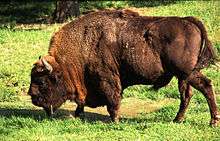Heinz Heck



Heinz Heck (22 January 1894 – 5 March 1982) was a German biologist and director of Hellabrunn Zoo (Tierpark Hellabrunn) in Munich. He was born in Berlin and died in Munich.
With his brother, Lutz Heck, who was director of the Berlin Zoological Garden, he worked on two breeding back projects to recreate extinct species. The Heck horse aimed to recreate the tarpan (the true European wild horse, ancestor of all European domestic horse breeds), and the Heck cattle, aimed to recreate the aurochs, the wild cattle of the European forest.[1]
This work has been criticised on grounds that once an animal is extinct, it cannot re-exist. This is contrary to Heck's view, which is that while genes of an extinct animal still exist in extant descendants, the animal could still be recreated.
Heck also played an important part in saving the European bison (wisent) from extinction when the majority of its population of about 90 survived in captivity in Germany following great losses to the species during World War I. To help manage the survival of the European bison from the remaining captive population, he commenced the first studbook for a non-domestic species, initially as a card index in 1923, leading to a full publication in 1932.[2] Thanks to Heck's efforts, the European bison population has significantly increased and the species has been re-released into the wild.
See also
Further reading
- Van Vuure, Cis (2005). Retracing the Aurochs: History, Morphology and Ecology of an Extinct Wild Ox. Sofia, Bulgaria: Pensoft Publishers. ISBN 978-954-642-235-4.
References
- ↑ Heck, H. (1951). "The Breeding-Back of the Aurochs". Oryx. 1 (3): 117. doi:10.1017/S0030605300035286.
- ↑ Tudge, Colin (1992). Last Animals at the Zoo. Washington, D.C.: Island Press. ISBN 1-55963-158-9.